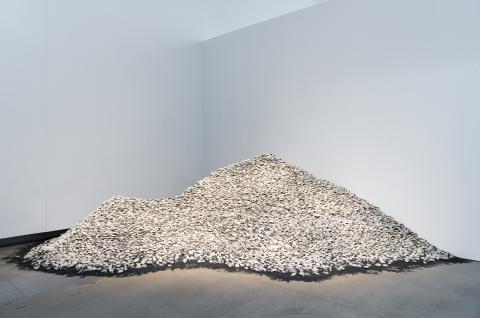Megan Cope | Artist
By The Last Word
Artlines | 1-2020 | March 2020
Every issue, we invite an artist, curator or friend of the Gallery to share their practice and passions with us. For our first issue of 2020, Artlines spoke with Quandamooka artist Megan Cope, whose historically informed work RE FORMATION 2019, recently acquired for the Collection, features in ‘Water’.
Explain the essence of your practice in 50 words or less.
My site-specific sculptural installations, video works and paintings investigate issues relating to identity, the environment and mapping practices. The work often resists prescribed notions of Aboriginality, and instead, map psycho-geographies that challenge the grand narrative of ‘Australia’, as well as our sense of time and ownership in a settler colonial state.
Describe your studio or work area.
I work across two spaces: from home in a big backyard studio attached to a couple of old sheds, surrounded by plants and birds and a living midden in suburban Melbourne; and a small space in a caravan on our Quandamooka Country, by the saltwater.
How has your practice changed over time?
My practice has moved from painting (ten years ago) into sculptural and installation works in the last four years. However, all my art is based on the same theoretical frameworks. And in a way, the works still manifest as maps, landscapes and psycho-geographies, through which I seek to insert Quandamooka (North Stradbroke Island) and Indigenous pedagogies into a contemporary practice.
What work do you most enjoying doing?
Problem-solving and finding ways to connect material outcomes to the things I feel compelled to discuss in my practice. I also like figuring out ways to help people remember the important parts of history that have shaped our social, economic and political realities.
How do you know when a work is finished?
One thing I’ve learned about my practice over the past decade is that each work informs the next, and that every body of work directly relates to the critical frameworks that underpin my practice. I know a work is finished when it feels like a completed chapter in the story, or when a new body of work emerges from the things I learnt during the last.
Where did you grow up, and how do you think this has influenced your practice?
I grew up in the Huon Valley in Tasmania. It had an enormous influence on me, growing up in the bush and by the saltwater. My father built fish traps that we would store oysters in, which we harvested down near Esperance River. I would catch salmon and squid after school. We spent some holidays on culture camps with local mob, learning about the black history and traditional muttonbirding on Bruny Island (off the south-east coast of Tasmania). On other school holidays, I would come up and stay with Nanna on Minjerribah (North Stradbroke Island).
Are artists valued in our society?
According to the federal government, the arts are no longer worth a department. However, the recent climate crisis has seen incredible creativity, generosity and action being led by artists across all artforms, so I think Australians really need to support the arts more, not just financially, but also to keep expanding our visual literacy, education and culture as a nation.
What, if anything, do you listen to while you work?
Podcasts, ABC Radio National programs like Awaye!, Off Track and Big Ideas, and I’ve just finished listening to Dolly Parton’s America, which was an incredible journey!
Feature image: Quandamooka artist Megan Cope assembling RE FORMATION 2016–19 for ‘Water’, GOMA, 2019 / Photograph: C Callistemon, QAGOMA
Connected objects

RE FORMATION 2016-19
- COPE, Megan - Creator
Related artists
COPE, Megan
1982
- present
Full profile
for COPE, Megan
Metadata, copyright and sharing information
About this story
- Subject
